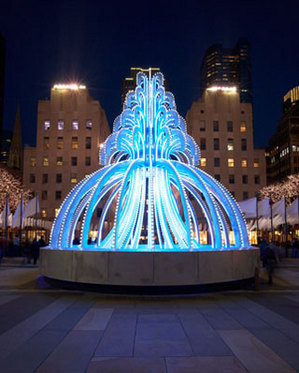This is an archive of the ArtCat Zine, 2007-2009. Please visit our new project, IDIOM.
After the Deluge at X

Last night at the X Initiative, Lindsay Pollack led a panel entitled AFTER THE DELUGE? PERSPECTIVES ON CHALLENGING TIMES IN THE ART WORLD. The topic was clearly on the minds of many, as well over three hundred people packed the second floor of the old DIA space. With early Derek Jarman cycling eerily in the background, and the oblivious, hissing steam pipes quickly bringing the room to a broil, Pollack peppered Jefferey Deitch, of the eponymous Projects, Brett Littman, ED of The Drawing Center, Michael Rush, Director of the Rose Museum and Anya Kielar, doing double duty as an artist and as a former gallerist at Guild & Greyshkul.
The combination of the heat, the disparate panel, and the who's who crowd could easily have led to an heaping serving of platitude before everyone slunk up 10th avenue to one of the myriad openings on offer. Fortunately for all, Pollack took the opportunity to remind everyone in attendance how refreshing good journalism can be, and her guests, perhaps sensing that they were among friends, were remarkably candid and open, even as Pollack hit them with multiple follow up questions.
Rush, in particular, seemed eager to damn the torpedoes early and often, taking the first opportunity to remind everyone that, worldwide protests non-withstanding, the Rose is still due to be shuttered and its collection sold to ease Brandeis's financial situation. Rush emphasized that the Rose's own finances were relatively stable, considering the challenges facing all arts organizations at present, and that the selling of the Rose remains at the center of the university president's personal plan to rescue his institution. Rush painted a vivid picture of a largely independent organization, having been built and funded almost entirely of its own initiative, led to the financial slaughter at the hands of a rapacious and unfeeling bureaucracy. He indicated his support for legislation, introduced by Richard Brodsky, that would make it illegal (in New York) for institutions to sell donated works in the manner that Brandeis is currently attempting, as well as his sympathy for the many donors whose gifts would now be sold against their wishes, saying wistfully at one point, "a lot happens on good faith, and I think those days are over."
Apropos of nothing, Brett Littman began the evening with a hurried power point presentation diagramming how the structure of the art world has changed over the past several centuries. Later, addressing the topic at hand, he would say that the Drawing Center would shift from eight shows to six, but expressed optimism that the economy would force institutions to use their collections in new ways, a sentiment seconded by Rush. Littman also made the point that during the recent madness gallerists were often more willing to "step over the line" and attempt to influence institutional decisions about what works should be shown and how. Littman seemed pleased at the thought of humbled dealers and their ilk returning to their regularly scheduled role, leaving professional decisions to the qualified.

Deitch expressed a similar feeling but in the opposite direction, saying that he was happy to finally have an excuse to 'say no,' to some of the more expensive project proposals that came across his desk. He also spoke at length, with Pollack's prodding, about what he termed 'the confusion of aesthetic and market values,' or the belief, apparently widely held, that the most expensive art is also the best. This would change, or so he hoped, in the near future; given the shifting buying practices of the "six billionaires" who had been setting the market in recent years, one of whom recently canceled all his previous purchases for the last six months. In an implicit contrast to Littman's lusting for a chastened private sector, Deitch argued that the recent proliferation of art fairs had made curators lazy, leading them to abandon such traditional tools as the studio visit and the gallery tour. Instead, curators had simply gone "to Miami for Art Basel 'cause it's more fun," giving one the image of an army of hung-over curators sheepishly filtering back into galleries, wearing dark glasses and making fumbled apologies for 'last night.' Or in this case, the past five years.
Anya Kielar, the only woman and the only artist on the panel, was also left to cover all those galleries that are not multimillion dollar, international institutions. At her own recently closed Guild & Greyshkul, she had seen the writing on the wall when she realized she was borrowing from her artists to pay her bills and her staff. Indeed, the contrast between her own candid admission that she now relies on her MFA, which allows her to teach art in a prison, for a living and Deitch's relief at not necessarily having to fund million-and-a-half dollar projects like Electric Fountain could not have been more striking. Kielar also voiced the now familiar sentiment, echoed by the other panelists and heard throughout the art world recently, that this economy might push things to be "a lot more renegade," and that this was surely positive.
Or, as Rush put it earlier in the evening: "Two years ago we would gather like this, and all we would talk about was the money. And now the economy has crashed and all we talk about is the money. Maybe, just maybe, this can help us move beyond the money."
ZINE
HOME
TIPS / COMMENTS
CATEGORIES
CONTRIBUTORS
- Greg Afinogenov
- B. Blagojevic
- Adda Birnir
- Susannah Edelbaum
- Julie Fishkin
- Paddy Johnson
- Jessica Loudis
- Christopher Reiger
- Andrew Robinson
- Peter J. Russo
- Blythe Sheldon
- S.C.Squibb
- Hrag Vartanian
